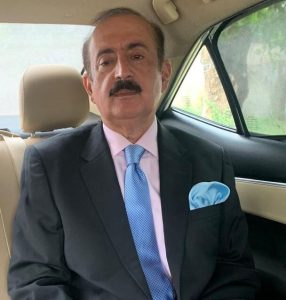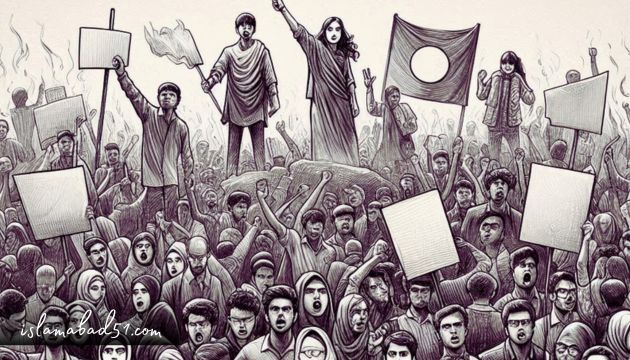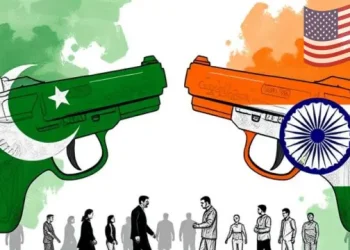By: Shahzada Ahsan Ashraf
The rapid changes in the situation in Bangladesh have left the world in awe. Analysts worldwide are astonished at how, in just a few days, middle-class students rose up like a storm, overthrowing one of South Asia’s most powerful Prime Ministers. With this question in mind, a columnist reached out to some well-informed friends through digital waves.
When a Bangladeshi intellectual was asked where the student movement got its motivation from, he replied, “Many people don’t realize that we are willing to go to the very end for our freedom because we are the heirs of the blood spilled by Siraj-ud-Daula and his companions in the fields of Plassey.
Our youth are the sons of Waqar-ul-Mulk and Mohsin-ul-Mulk, in whose home the party was born that became the standard-bearer for the rights of Muslims across the subcontinent and liberated us from Hindu slavery. The brave youth of Bangladesh were destined to do the same.”

A Bengali writer mentioned, “The spirits of Hussain Shaheed Suhrawardy, Maulvi Tamizuddin, Nurul Amin, and Fazlul Qadir Chowdhury have continuously questioned why we sided with India in breaking up Pakistan. This question hammered at our minds and weighed on our conscience, a burden that the youth have now lifted.”
When a retired Bangladeshi civil servant was asked why the students destroyed the statues of Bangladesh’s founder Sheikh Mujibur Rahman, he said, “The youth believed that we had been turned into a state of India, and Sheikh Mujib and his daughter Sheikh Hasina were responsible for this.
The youth’s hammers didn’t just break the statues of Mujib and Hasina; they shattered Indian dominance.”
A well-informed journalist residing in Dhaka stated that the Bengalis have achieved their third independence on August 5th. The first was in 1947 when Muhammad Ali Jinnah and Suhrawardy freed us from Hindu majority rule. In 1971, we gained freedom from General Yahya and his clique, and now, on August 5th, the students liberated the country from Indian subjugation.
Mujibur Rahman had placed us in India’s lap, and his daughter had practically turned Bangladesh into an Indian colony. Ministers, generals, judges, and high officials in Bangladesh were appointed with Delhi’s approval. The curriculum taught in educational institutions was prepared in India.
The lava that had been simmering for decades against Indian hegemony and slavery erupted like a flood, sweeping everything away.
When I asked, “Why did such a powerful Prime Minister prove to be a wall of sand?” the response was, “The onslaught of oppression has been defeated by the outcry of patience.
” Abu Saeed, a student at Begum Rokeya University in Rangpur, stood tall and declared, “Shoot me, I will not back down.” As soon as Abu Saeed’s bloodied body hit the ground, every student in Bangladesh rose up, standing like a rock against oppression.
The Awami League’s Chhatra League had instilled such fear in educational institutions that no one could dare stand against them. The Rapid Action Battalion, responsible for Hasina’s personal security, had spread terror.
The army, judiciary, and administration were her slaves and tools, but in the grand scheme of things, neither Hasina nor Modi’s will prevails. Here, the power to say “Be” belongs to that magnificent entity who uses fragile sparrows to destroy armies of elephants.
On July 20th, when Hasina unleashed all the forces of oppression, the students of Bangladesh wrote an incredible history of courage, perseverance, and sacrifice.
The young students, both male and female, kept falling to bullets, but no one retreated. In one day, 1,500 young people were martyred, but their blood illuminated the path for the nation.
At that moment, the defiant call of their brave and fearless coordinator, Naheed Islam (son of retired teacher Badar-ul-Islam), resonated across the country: “Come out of your homes, hostels, colleges, and universities, and eliminate every symbol of slavery and oppression from your land.
Swear to the souls of the martyrs that we will not return until we have achieved complete freedom for our country.” When millions of students took to the streets, neither the police nor the army could stand in their way.
When asked if the students were receiving support from any foreign country, the answer was, “Their sources of strength are far more powerful than any nation. They draw courage, patience, determination, and strength from Badr, Karbala, Gaza, Plassey, and the gallows of Dhaka Jail.”
A Bengali friend living in London said, “This movement isn’t just about ending the unjust quota system; it’s about reviving the Two-Nation Theory.” When I asked another Bengali intellectual the same question, he said, “Our youth felt they had many debts to pay—the debt of siding with Hindu India against Muslim Pakistan in 1971, the debt of remaining silent in the face of Sheikh Hasina’s brutal repression, the debt of remaining neutral over the death of a noble figure like Professor Ghulam Azam, and the debt of failing to save the lives of venerable leaders like Abdul Quader Molla, Quamrul Islam, Ali Ahsan Mujahid, Motiur Rahman Nizami, and Mir Quasem Ali, who were hanged. On August 5th, the students repaid all those debts.”
The poet Iftikhar Arif came to mind:
miTTi ki mohabbat men ham ashufta-saron ne
vo qarz utare hain keh vajib bhi nahin the
(In our love for this land, we, the passionate ones, have repaid debts that were never even due.)
(The writer is a Former Chairman and Managing Director PIA, Former Federal Minister of industries and production)
Disclaimer: The views expressed on this website are those of the individual authors and may not reflect the opinions of the site or its owners.














